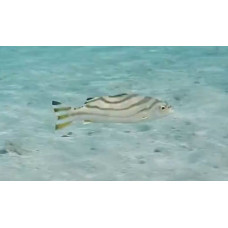Latin name
Terapon jarbua
Other name
Crescent grunter, crescent banded grunter, crescent perch, spiky trumpeter, thornfish or tiger perch.
Identification
The Jarbua terapon has an oblong body, moderately compressed laterally. The mouth is oblique, with jaws of equal length. The maxilla reaches the anterior edge of the eye in juveniles and the center of the eye in adults. The fish possess conical, slightly recurved teeth arranged in rows, with teeth in the outer rows significantly enlarged. Juveniles have teeth on the roof of the mouth (vomer and palatines), which are often absent in adults. The lateral line contains 75–100 porous scales.
Features of Fish Fins
The dorsal fin has 11 or 12 spines and 9–11 soft rays. The spiny portion is deeply notched, with the fourth to sixth spines being the longest. The anal fin has 3 spines and 7–10 soft rays. The caudal fin is emarginate (forked with pointed tips).
Fish Coloration
The body is silvery-white with 3–4 curved dark stripes running from the nape to the caudal peduncle. The lowest stripe extends through the center of the caudal fin. A distinctive black spot is present between the third and sixth spines of the dorsal fin. The caudal fin is striped, with black tips on each lobe. This coloration and small scales may serve as an adaptation to avoid detection by predators.
Distribution
Widely distributed across the Indo-Pacific region, from the Red Sea and East African coast to South Africa, throughout the Indian Ocean (including the Persian Gulf), and into the Pacific Ocean as far as Samoa. Their range extends north to Japan and south to the Arafura Sea and South Africa. A single specimen was reported in the eastern Mediterranean Sea in 2010, likely introduced via the Suez Canal.
Habitat
A euryhaline species (tolerates salinity ranges from freshwater to 70‰), inhabiting diverse environments: marine zones, coastal waters, estuaries, lagoons, and freshwater bodies. While primarily marine, it ventures far upstream into freshwater. Juveniles are abundant in intertidal zones with sandy substrates and tidal pools.
Size
A medium-sized grunter, commonly reaching about 25 cm (9.8 inches) in total length. The maximum recorded length is 36 cm (14 inches).
Behavior
Juveniles are territorial and excavate craters in sand, likely to maintain position during tides. Schools form at 2–5 cm (0.8–2.0 inches) standard length, but individuals become territorial at 9–15 cm (3.5–5.9 inches). This species produces sounds using extrinsic swim bladder muscles for communication, with variations linked to age and environmental changes.
Food and Feeding Habits
A predatory species feeding on small fish, but also acts as a cleaner fish by consuming ectoparasites and scales of larger fish (lepidophagy). Scales provide high caloric intake. Diet also includes insects and invertebrates.
Reproduction
Reaches sexual maturity at a total length of 13 cm (5.1 inches). Spawning occurs in marine environments.
Fishing
Caught using various coastal fishing methods, including gillnets, traps, hook-and-line, and bottom trawls.
Relationship with Humans
Sold fresh, dried, or salted. Rarely featured in the aquarium trade.
| Classification | |
| Phylum | Chordata |
| Class | Actinopterygii |
| Squad | Centrarchiformes |
| Family | Terapontidae |
| Genus | Terapon |
| Species | T. jarbua |
| Features | |
| Conservation status | Least Concern |
| Habitat | Neritic |
| Life span, years | No information |
| Maximum body weight, kg | No information |
| Maximum length, cm | 36 |
| Sailing speed, m/s | No information |
| Threat to people | Edible |
| Way of eating | Predator |
Jarbua terapon
Tags: jarbua terapon

